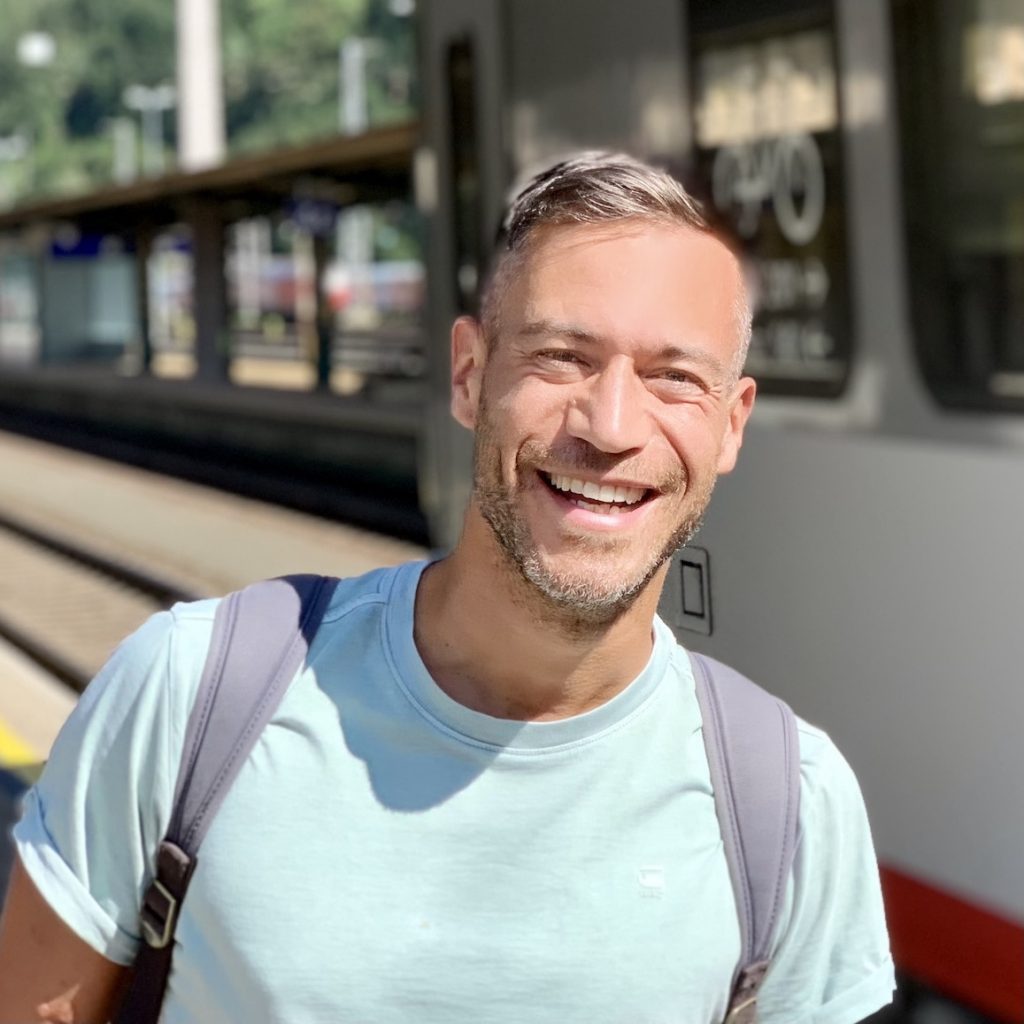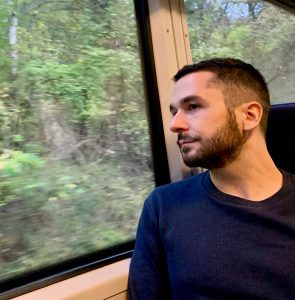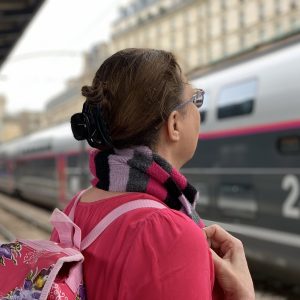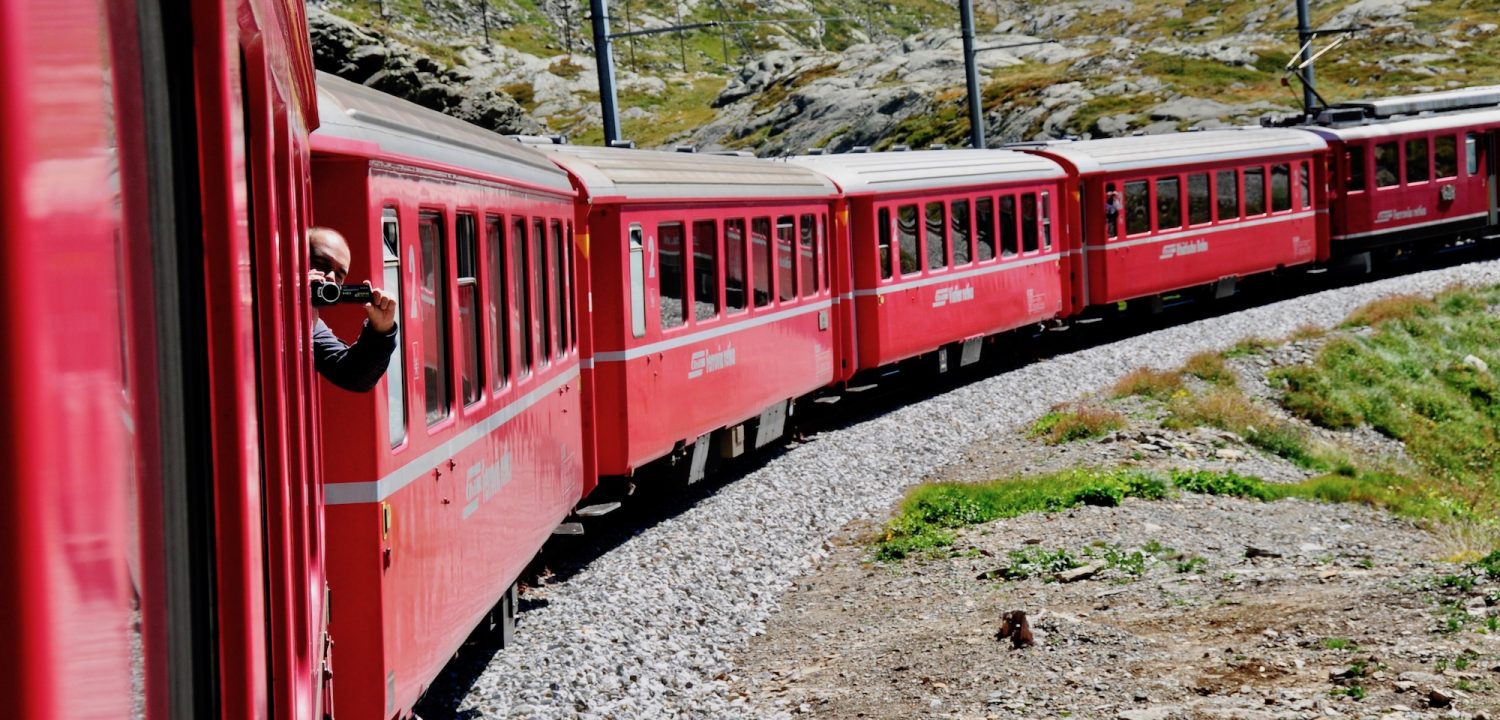We are Railtripping…
For many, travelling by train is a rite of passage, an uplifting experience, a romantic adventure. It also happens to be our passion and we are keen to share our years of experience travelling the world by train, discovering the most beautiful routes and destinations while reducing our carbon footprint.
Sustainable options are firmly at the forefront of all that we do, from encouraging rail travel to promoting local guides, eco-hotels and sustainable restaurants. Our goal is to nurture tourism that is of benefit to local communities, not a burden.
Join our Railtripping-community and travel the eco-friendly way:

Explore Europe’s most exciting rail routes

Discover new destinations off the beaten track

Delve into the history of places along the way

Support local, ethical and sustainable companies

Sit back, unwind and reap the rewards of slow travel

Enjoy views and comfort over traffic and flight shaming

Take advantage of our real experience on these routes

Help protect the planet by reducing your carbon footprint
Meet our team

Bart Giepmans

Gerdien Barnard

Paulo Marques

William Simpson

Michael Bartnik
Managing editor (German) & translator
My interest in tourism and slow travel began back in 1998 when I worked in a local travel agency selling holidays. It was around then that Deutsche Bahn launched their legendary Schönes-Wochenende-Ticket, which made having a weekend away much more affordable. To further promote rail travel, we even published a guidebook for some popular train journeys — the VCD-Tourenplaner.
Since then, I’ve worked at S-Bahn Berlin, Deutsche Bahn, Swiss Federal Railways (SBB), ETH Zurich, Berliner Zeitung and finally a consulting firm, where I work in the mobility sector. These days, I develop and test innovative mobility solutions in Berlin that will change the future of transportation.
Favourite Train Route
The Bernina Express across the Swiss Alps is definitely my favourite. It’s actually a World Heritage Site and the landscape you pass is unlike anything I’ve seen before. From Chur, the train climbs steadily before crossing the impressive Landwasser Viaduct over a deep canyon and rushing river. The train then proceeds through breathtaking scenery, over bridges and viaducts and through long tunnels. At Preda, you can even get off, hire a sledge and race down a mountain pass to the village of Bergün. It’s not to be missed!
Most frequent route
The train I ride the most is Berlin’s city railway – the S-Bahn. What I like about it is that the railway mirrors the city’s varied history, from the Prussian tracks at Museuminsel and the ‘roaring twenties’ vibe at Friedrichstraße to the socialist architecture at Alexanderplatz and the modernist masterpiece of Berlin Hauptbahnhof.

Bart Giepmans
Co-Founder & chief editor
Slow and sustainable travel has been a passion of mine ever since my dad bought me a Dutch travel card for my tenth birthday and I was able to discover the Netherlands by rail. Since then, I’ve been discovering routes in Europe and further afield – always enjoying the slower pace of travel, talks with locals, and drinks in the bistro.
The trains have also been key to my career, having worked for both the Dutch and German Railways as well as for Switzerland Tourism and Interrail. I’ve always wanted to make rail travel sexier and motivate people to stop flying and take the train instead. I never could have imagined that slow travel would become what it is today.
Favourite Train Route
Impossible to say, but the narrow-track railway from the village of Krimml in Austria to Zell am See is definitely up there. Starting at the Krimml Waterfalls, the route runs through the Salzach Valley with imposing scenery on both sides. Pulling in to Zell am See is always a delight – in summer, I used to jump straight into the lake within a minute of arriving!
Most frequent route
I must have travelled the Utrecht–Den Bosch route in the Netherlands over a thousand times, but the novelty never wears off. Crossing the Lek River and watching the scenery pass by or the sun setting over the water – it’s just fantastic. It never gets old.

Bonnie Joosten
Co-Founder & partnerships
I first developed my passion for rail travel while working for the Dutch Railways. I loved how comfortable and rewarding it was to cross Europe and meet people on a train. I fell in love with it. Later in my career, I wanted to make a sustainable impact closer to home so I started working for an NGO in Amsterdam.
Today, I seek to combine my two passions – sustainability and travel. I want to transform tourism, to make sure that it impacts local people’s lives in a positive way and protects nature, rather than harms it. I want to create a world in which we travel differently but still gain an understanding of other cultures and ourselves. That’s why slow travel is the new now.
Favourite Train Route
I’d have to say Ljubljana–Zagreb. Connecting Slovenia and Croatia, this stunning two-and-a-half hour route crosses the mountains along the River Sava with fantastic views almost the entire way. I also love the route from Seebrugg to Freiburg via Titisee in the Black Forest, which goes through thick forests and passes mountains and lakes – it’s beautiful. As someone from the Netherlands, this dramatic kind of scenery has always amazed me!
Most frequent route
Amsterdam–Brussels Midi. I used to travel this route a lot for work but I can’t actually remember many of the views…because I was always chatting to the staff on board! They were always so friendly that I completely forgot to look out of the window, for a change.

Paulo Marques
Brand and web designer
Portugal may not have an extensive or well-connected rail network, but that never stopped me from falling in love with trains, even as a kid when my favourite toys were always model trains and railways. Today, whether I’m winding through Germany and the Czech Republic along the banks of the River Elbe or lurching across the Yellow River on a high-speed train between Beijing and Shanghai, trains still fascinate me. Yes, they’re affordable and sustainable, but for me you just can’t beat the sensation of watching the world pass you by from a train window.
Favourite Train Route
Considering I’m Portuguese, I’d be remiss if I didn’t use this space to plug the Linha do Douro, a railway in northern Portugal that links the coast with the mountainous wine region of the same name. The train twists and turns through valleys and gorges, the vineyards that grow grapes for port wine plunging down towards the Douro River. It’s a slow but beautiful trip all year round.

Britta Rübsam
Managing editor (German) & translator
To begin with, my interest in rail travel was purely pragmatic. I didn’t have a car until I was 30, so whenever I wanted to visit loved ones the train was my only option. For years, the railway was my route home. I developed a fondness for it, placed my trust in it. As in any good relationship, there were moments of gridlock and despair but the connection still exists. Today, I travel by train to not miss out on adventures!
My professional journey has also passed through a number of stations, from Kunsthalle Düsseldorf and The Body Shop to Düsseldorf Marketing & Tourismus and Ruhr Tourismus, before finally ending up as a freelancer. Letting my passion shine through is something I’ve found invaluable wherever I’ve worked.
Favourite Train Route
I admit I’m somewhat of a city person. I grew up in the countryside and have had my fill of nature. But when my local train, the Sauerland-Express, leaves the Ruhr valley in western Germany and the grey graffitied walls of the city make way for a rural landscape with hills and fields as far as the eye can see, it fills me with a sense of nostalgia. It feels like coming home!

William Simpson
Managing editor (English) & translator
My passion for slow travel was probably sparked as a kid when we’d take the overnight train from London to Cornwall each summer. There was a thrill to waking up in a different city. In the years since, my friends and I have travelled by train as much as possible – interrailing around Europe, crossing China by train and doing the Trans-Siberian Railway. I also regularly rope friends into complex 12-hour journeys on slow trains across Germany simply because it’s cheap, sustainable and you see so much more of the country.
Favourite Train Route
The route between Beijing and Ürümqi in China’s north west is a pretty unique experience. Over the course of 30 hours, you cross essentially half a continent – winding through smog-choked cities and across arid plains, past sand dunes and green oases and packs of wild camels galloping alongside the tracks. You find a China you’re unfamiliar with, one where the locals are Muslim, speak a Turkic language and look Central Asian. It strikes you just how vast and diverse the country is.

Lily Ovaa
Editor
I first got a taste for rail travel in the Netherlands when, as a teenager, you could buy an unlimited travel ticket, and I’ve stayed true to the railways ever since. There’s no other mode of transport quite as relaxing. You don’t get tired, you don’t sit in traffic jams and you get to enjoy whatever landscape you’re passing through. With a bit of luck, you’ll even meet some other travellers who’ll inspire you to go on a new adventure. It’s also the ultimate proof that comfort and efficiency can easily be combined with a climate-conscious lifestyle.
Favourite Train Route
I have fond memories of the train on Java, which winds its way (surprisingly comfortably!) through stunning scenery. But I also love the line from Amsterdam to Vlissingen. As you leave Rotterdam, you notice the dialect starting to change along with the landscape outside. As urban sprawl gives way to countryside, the letter ‘g’ softens until it all but disappears and becomes an ‘h’. That’s when you know you’re headed to Zeeland, the westernmost province of the Netherlands. After Roosendaal, the view empties out and when you finally cross into Zeeland, you’re met with endless skies and a characteristically beautiful light.
Most Frequent Route
The train I use the most is the RER, the commuter rail service that serves Paris and its suburbs. It’s a fascinating combination of urban and provincial transport that is the lifeblood of the Parisian economy and, by extension, the nation’s as a whole. Within the city it mostly runs underground, but in no time at all you’re speeding out of the grey city environment and into a pleasant rural landscape.


